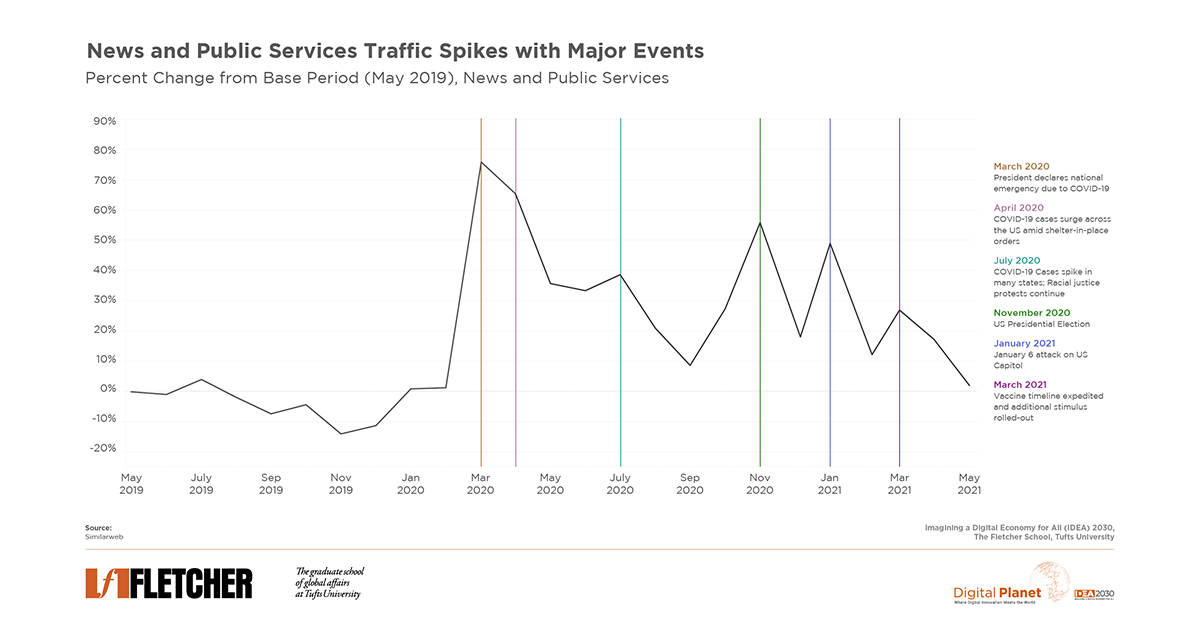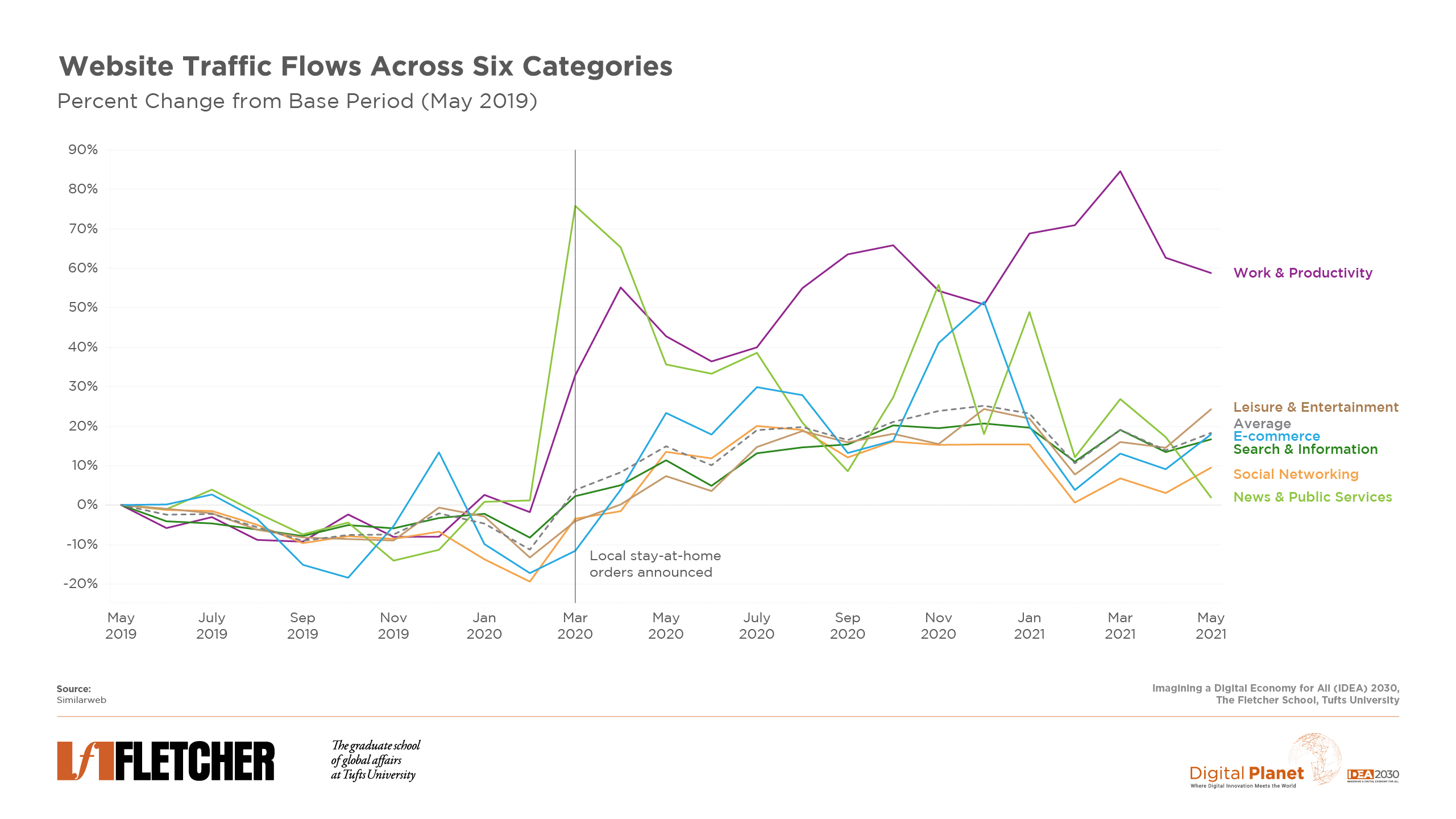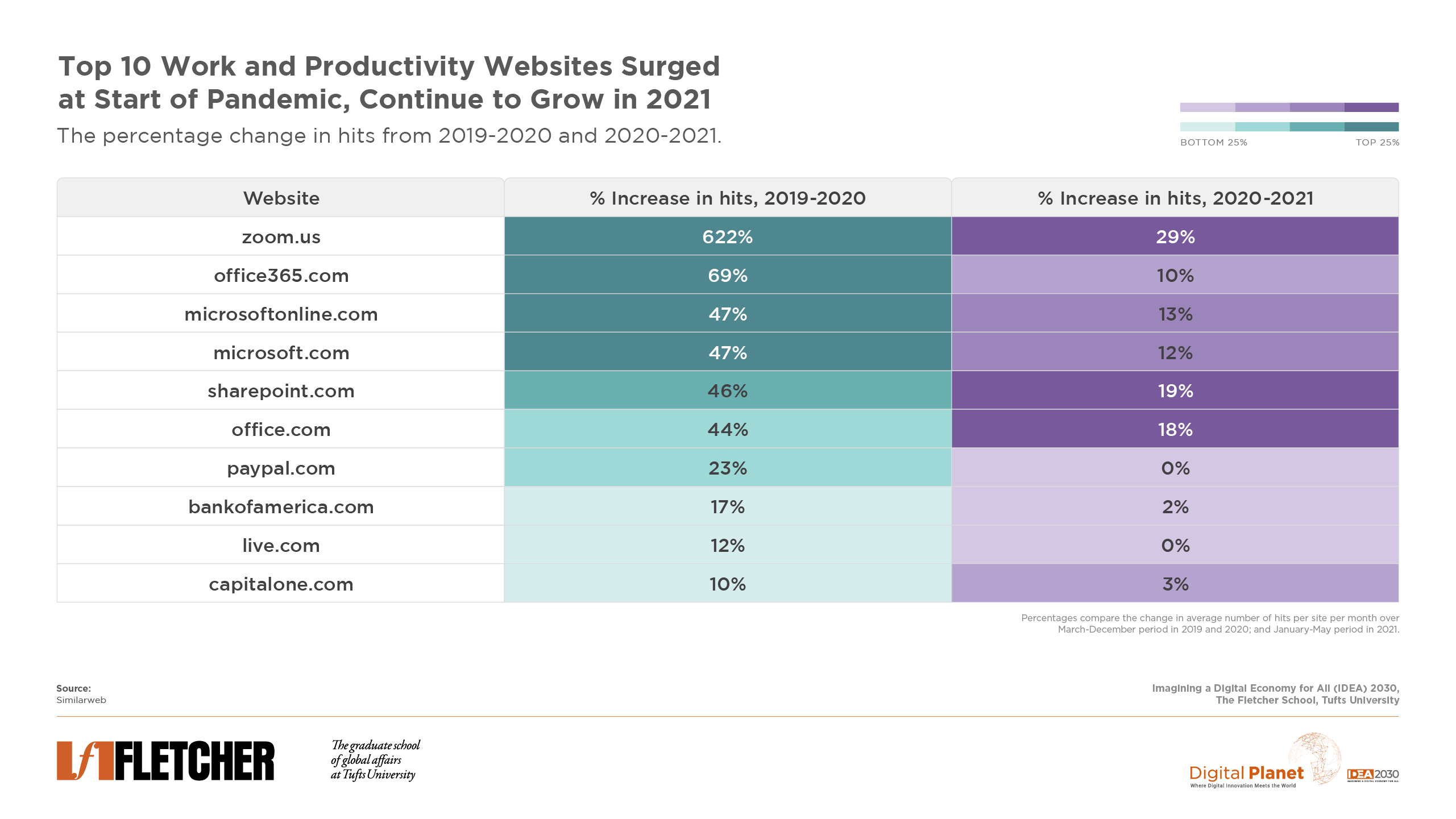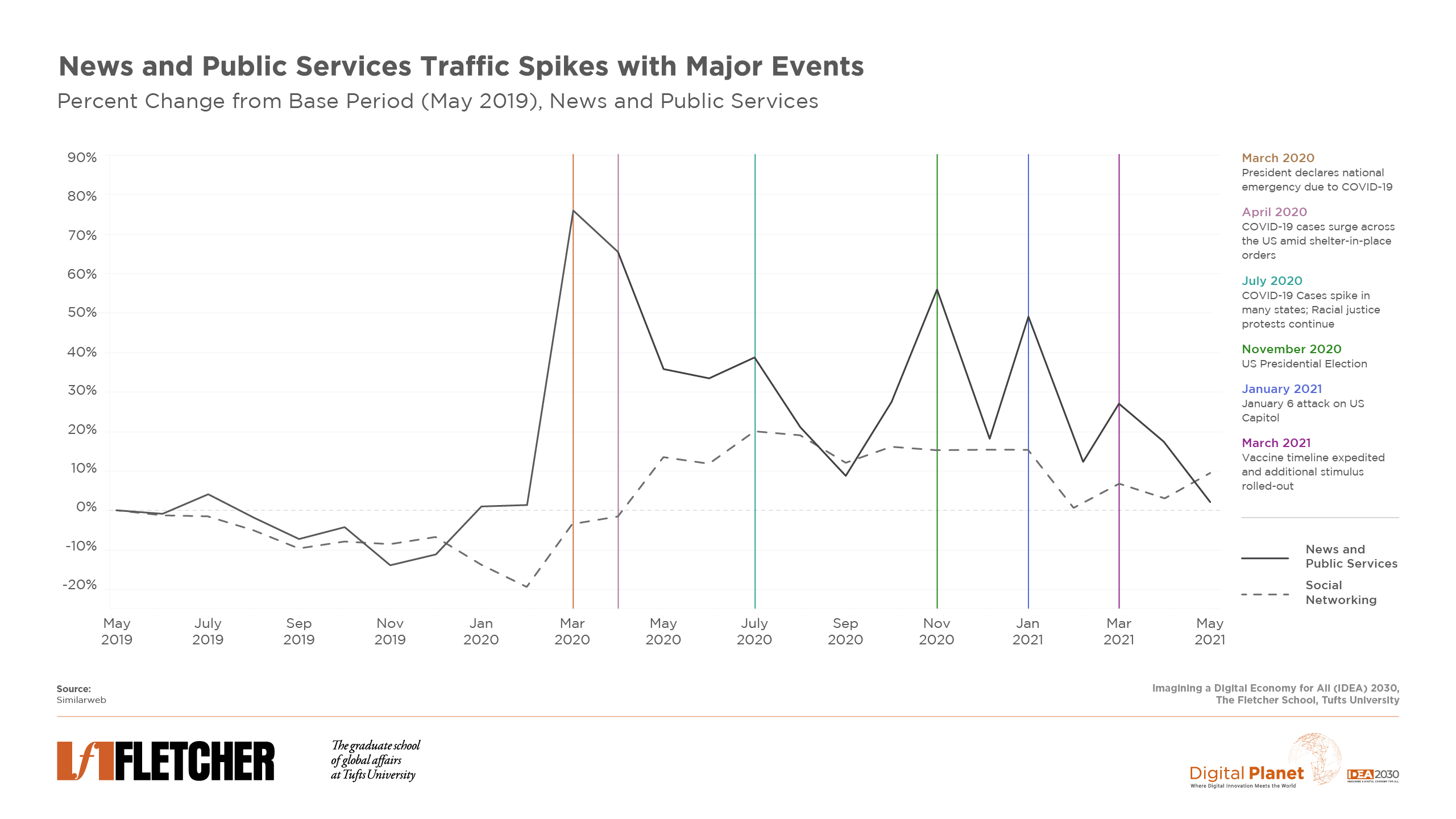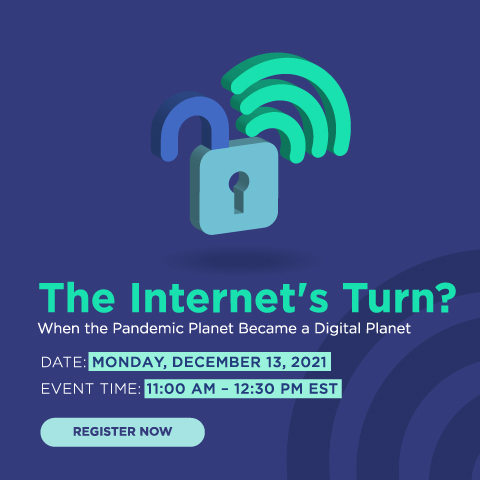Home > Off the Charts > The Long Shadow of the Lockdown
The Long Shadow of the Lockdown: How the Pandemic Altered the Way Americans Spend Time Online
In the face of pandemic-induced lockdowns, the internet kept Americans connected. We scoured the news for vital information, shifted to virtual work where possible, and shopped and socialized online. As the lockdowns lifted and the United States began navigating its way out of the pandemic, we examine how Americans spent their time online, and discuss implications for those on both sides of the digital divide. We find that work and productivity-related consumption increased significantly, and maintained a dominant position throughout the pandemic cycle, suggesting that a shift to work-related digital platforms is more than a passing trend. Attention to news and public services was far bouncier, fluctuating in response to policy changes and rollouts of key information. While social media usage increased slightly, it saw the smallest pandemic bounce, and tapered off in early 2021, dropping closer to pre-pandemic levels.
In early 2020, as the world moved into lockdowns, digital activities began to replace in-person interactions. As work, school, social interactions, and shopping shifted online, consumer and business adoption of digital technologies witnessed a surge globally—we advanced digitally by 5 years in just 8 weeks according to analysts at McKinsey, a consultancy. While screen time increased and big tech reaped record profits, it was not immediately clear precisely how Americans were spending their increased time online and whether these changes in habits reflected an acceleration of underlying trends or were simply a fleeting pandemic bounce.
Using data from Similarweb, we explored these questions by analyzing traffic to the top 100 websites over a two-year period from May 2019 to May 2021, capturing online activity pre-pandemic, during the height of stay-at-home orders and social distancing, and through the ebbs and flows of initial re-openings. This analysis segments websites into six broad categories to facilitate comparison: Leisure and Entertainment, News and Public Services, Work and Productivity, E-Commerce, Search and Information, and Social Networking. We computed the percentage change in traffic of each category over time, as compared to the baseline month of May 2019.
Our analysis revealed several patterns. Comparing across categories, we see three key shock-spikes during the lockdown: first, consumers in the United States rushed to News and Public services for vital information; they quickly adjusted to remote work almost concurrently; and around May 2020, e-commerce and social media use witnessed relatively modest spikes. Deeper dives into individual categories illustrate the nuances of how all this time online was spent.
Americans were highly reliant on digital technologies to get their work done, and the shift to remote work may be here to stay.
It is clear that the pandemic introduced a major shift in the nature of work, with Work and Productivity sites seeing the second largest jump in the first month of the pandemic. The work-from-home accelerations in 2020 and 2021 reveal the emergence of a tale of two digital economies: some—disproportionately white and Asian workers—worked entirely from home, while other frontline and essential workers (disproportionately Black) continued with their high-touch jobs that enabled the rest of us remain ensconced in our connected homes. Many others were unable to work at all due to massive layoffs: Hispanics, for example, were likelier than other groups to lose their jobs during the pandemic. Women, and in particular women without college degrees, were hit harder by layoffs than men without college degrees.
Even as the unemployment rate peaked at 14.8% in April 2020, Work and Productivity websites spiked 58% between February 2020 to April 2020, reflecting this divide between remote and in-person professions. This marked increase also reaffirms the findings of the U.S. Labor Department, where jobs that integrated digital connectivity easily transitioned into remote work settings, but entire sectors such as leisure and hospitality were forced to a standstill.
The acceleration to remote work was both dramatic and sticky. In 2019, one in seven people worked primarily from home, whereas in 2020, one in three worked remote. For many professionals, remote work is becoming the preferred option: a recent MIT study found that of those who were employed before the pandemic, about half are now working from home, with 33% of people reporting that they had just recently (as of July 2020) switched from commuting to working from home.
A closer look into the Work and Productivity category shows that Office365.com and Zoom.us had the highest visitor surge during the first year of the pandemic. For example, Zoom’s website experienced a 622% increase in average hits per month from 2019 to 2020, and then increased a further 29% between 2020 and 2021. Interestingly, Work and Productivity usage has continued to rise regardless of where we are in the pandemic cycle. Now, as firms navigate returning to the office, many are facing pressure to offer hybrid work environments, more flexible schedules, and even continue remote work long-term. Work and Productivity related digital platforms, deemed essential throughout 2020 and most of 2021, may now become indispensable.
Economic anxieties peaked in 2020, and began to plateau in early 2021.
A further investigation into the top Work and Productivity sites reveals—as seen in the table above—an increased use of banking websites in the first year of the pandemic but, unlike daily office-work-related websites, plateauing in 2021. This evidence of early economic anxiety is not entirely surprising, given that Americans were the most likely among economically-advanced countries to report challenges in meeting their basic needs, with 31% saying in a 2020 survey that they were “unable to pay for basic necessities like food, heat or rent, and/or used up all or most of savings, and/or borrowed money or took out a loan” due to the pandemic. By early- to mid-2021, the picture improved slightly for Americans, with the second and third stimulus payments disbursed in January and March of that year, leaving consumers’ checking accounts better off than they were pre-pandemic—but far from perfect, with 51% of Americans not having enough money to cover three months’ worth of living expenses, according to a July 2021 survey.
News and Public Services website traffic ebbed and flowed along with the news cycle, and outperformed Social Networking sites during the pandemic.
News and Public Services, perhaps the category most digitalized and scalable pre-pandemic, experienced the most seamless transition once lockdowns were in effect, with the largest bounce by far at the onset of the pandemic. As the news industry had largely transitioned away from print, top American publishers such as The New York Times and Bloomberg were able to quickly meet the high digital demand as the country flocked to the web to stay informed.
News and Public Services turned out to be a strong, yet volatile category across our research timeline, responding to the spikes in demand for news. Mirroring real-time public events that elicited interest from the general population, website traffic increased during Stay-At-Home decrees, government social programs, and vaccine developments, as well as political events like impeachment trials, primary campaigns, and the presidential election. While we at Digital Planet highlighted in our recent research the increasing vulnerability to misinformation, as have several others, it is noteworthy that Americans not only spent much more time on News and Public Services sites than on Social Networking sites during the pandemic, but they also went to authoritative sources for pandemic guidelines. For example, when vaccines were introduced, in early 2020, the CDC and NY.gov became the top-visited News and Public Services websites.
Christmas in July? E-Commerce facilitated Americans’ grocery shopping, fueled their retail habits, and kept consumerism alive.
Throughout April 2020 to February 2021, E-commerce visits were at or above roughly the same number of visits during the December 2019 holiday shopping bounce. For nearly an entire year, top e-commerce sites experienced the equivalent of a non-stop holiday shopping season. While e-commerce saw a decline in 2021 from 2020 highs, hits still remain well above the 2019 norm, confirming what 43% of consumers surveyed said about shopping for products online more often, that they would have previously purchased from brick and mortar stores. Within e-commerce, Amazon and Wal-Mart were consistently at the top of the most popular sites, while Costco, Target, and Etsy saw the largest percentage increases in hits from the 2019 base period to early 2021.
As our analysis shows, most Americans were spending much of their increased time online working, managing their finances, and attempting to access accurate information during a time of great stress and upheaval. Sadly, many Americans were unable to smooth over some of the sharpest edges of the pandemic because they were unable to access the internet—some due to lack of access, and others due to affordability. For those with access, many struggled with slow and unreliable speeds. While the recently passed infrastructure bill aims to close this divide through a $65 billion investment, our analysis suggests the actual figure needed to close the gap is closer to $240 billion. This is an important first step, but far more will be needed to achieve affordable, accessible internet for all Americans.
Methodology
Our analysis of Internet traffic trends compares aggregated movements among different categories of websites, using Similarweb’s data of the top 100 websites from May 2019 through March 2021. Each website was ranked based on the number of visits, and placed into six categories, created by the Digital Planet research team: E-Commerce, Leisure and Entertainment, News and Public Services, Search and Information, Social Networking, and Work and Productivity. The average number of hits per website for May 2019 was used as the base period to calculate subsequent increases or decreases in traffic. This analysis considers websites only, and does not examine app usage.
Categories were determined as follows:
1. E-Commerce is comprised of websites designed primarily for online shopping like Amazon, Etsy, and eBay.
2. News and Public Services is comprised of websites that are either visited by people seeking critical information about recent events or provide access to government functions, like The New York Times or state health agencies.
3. Leisure and Entertainment is comprised of websites that provide venues for gaming, video entertainment, and sports. Examples include Roblox and Twitch.
4. Search and Information is comprised of reference materials for topics like health and cooking, search engines, encyclopedias, and dictionaries.
5. Social Networking is comprised of websites like Reddit, Discord, and Facebook that facilitate digital socialization and networking.
6. Work and Productivity is comprised of websites that workers primarily use to run their digital office space. Prime examples include Microsoft and Zoom.
Underlying data for the charts are available here.
Student Analysts Mariam Amini, Uyen Chu, Reegan Coleman, Edbert Jao, Malavika Krishnan, Chidera Moghalu, Wabei Saboi, Francisco Salazar, Vikram Singh, and Eda Yilar worked on this analysis under the guidance of Bhaskar Chakravorti, Ravi Shankar Chaturvedi, Christina Filipovic, Anuradha Herur, and Joy Zhang at Digital Planet, The Fletcher School, Tufts University.
This research is a part of the IDEA 2030 initiative, made possible by the generous support from the Mastercard Center for Inclusive Growth.


